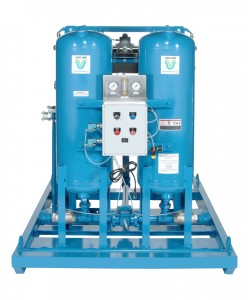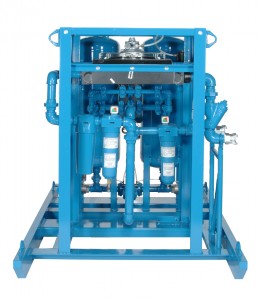Portable Compressed Air Dryers
Portable compressed air dryer construction is significantly different from the typical stationary industrial compressed air dryer. This equipment is constantly moved and sometimes abused. The valves and piping, electric and pneumatic controls, structural supports, and skids must all be heavy duty. We call this “rental tough”!
Over the past several years Van Air Systems has developed two new families of compressed air treatment products. These products cater to the portable air compressor rental markets. The anchor products we offer for those markets are the Blast Pak and Prep 40.
The Blast Pak and Prep 40 are sized to match up to portable air compressors ranging from 250 scfm to 1600 scfm.
We developed the Blast Pak for the mobile sandblasting and painting contractor. A contractor typically rents or purchases a portable air compressor after being awarded a sandblasting and painting project. A portable air compressor discharges hot, wet, and sometimes oily compressed air. If the compressed air is not treated prior to use for sandblasting and painting the results will be costly for the contractor. Wet compressed air clogs blast pots, corrodes blast nozzles, and causes flash rusting on the substrate that is being blasted. Paint jobs are also compromised because wet compressed air will result in “fisheyes” in the paint finish. The Blast Pak portable dryer cools the hot compressed air, separates the condensed moisture, and finally dries and filters the compressed air. The end result is clean and dry compressed air that is suitable to use for sandblasting and painting operations.
You probably notice when driving down the highway bridges covered with tarps. These bridges are being sandblasted and re-painted. The contractor will be using a portable air compressor and a portable compressed air treatment system to make sure he has clean and dry compressed air. The Blast Pak is ideal for this application because of its portability and durability. It is designed to be moved around on the jobsite.
Some other applications for the Blast Pak include:
Shipyards -- Ocean going ships must be blasted and re-painted every few years. In fact the U.S. Navy mandates the use of a compressed air dryer when its ships are being blasted and re-coated.
Water tower refurbishment -- Municipal and city water storage tanks need to be recoated periodically.
Power Plants and Refineries -- Blasting and re-painting of storage tanks and structural steel is always part of a sound maintenance program at these facilities.
Rail yards: Often a portable compressor is used to charge the air brakes on trains prior to departure. The brakes need clean, dry air.
Take a look at this video on the Blast Pak it pretty much tells the entire story.
https://www.vanairsystems.com/viewcategory/2/product-instructional-videos.html
The Prep 40 is the Blast Pak’s big brother. The Blast Pak assures that no moisture will condense in downstream components, which is great for a lot of applications as I mentioned above.
However, there are applications where customers have a more stringent moisture specification. Such a specification is almost always stated in terms of dew point. A typically stringent specification calls for a constant -40F or -100F outlet pressure dew point. Enter the Prep 40 portable compressed air dryer.
Here are photos showing Prep 40 model FR-800. This unit would typically be paired with a 750 to 900 CFM portable air compressor.
The Prep 40 is a complete portable compressed air treatment system that includes an after-cooler, separator, coalescing pre-filter, heatless regenerative dryer, and particulate after-filter. All components are mounted and piped on a rugged sled type skid.
When a manufacturing facility schedules a planned outage for maintenance, a portable rental compressed air system is often on site for the duration of the outage. Most of these facilities have stationary regenerative dryers for day to day operations, therefore they insist on that same quality of air from their portable rental dryer. The Prep 40 is an ideal fit for this type of application.
During hurricane season along the Gulf Coast in the southern U.S., refineries rent portable, generators, air compressors, and regenerative dryers at the beginning of the season. The refinery operator hopes to never need the equipment. But having a back-up compressor and dryer is cheap insurance in the event of a major power outage from a hurricane.
Before a new natural gas or oil pipeline is commissioned, it must be hydrostatically tested to insure the integrity of all the weld joints. Obviously, this means getting the pipeline wet. After the hydro-test the pipeline needs to be dried. Only then can gas or oil be introduced. The drying of a pipeline is accomplished by using portable air compressors and portable heatless regenerative dryers.
Also, pipelines may require inspection other than hydro-test prior to being put into service.
PIGS (pipeline inspection gauges) are propelled thru the pipeline by high pressure compressed air, typically at 350-500 psig to inspect and / or clean the pipeline. Portable air compressors and portable heatless dryers are used for this procedure as well.
At Van Air Systems we’re continually developing new products to support the portable compressed air user. Stay tuned for additions to our portable product line.


